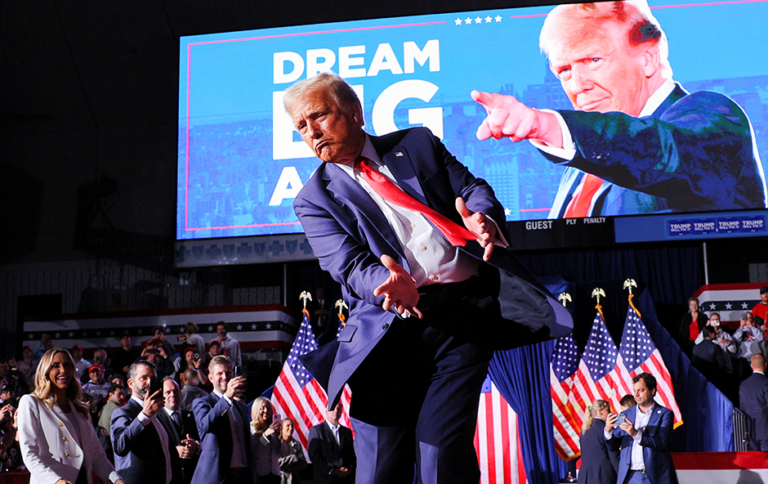This article originally appeared on Inside Climate News, a nonprofit, non-partisan news organization that covers climate, energy and the environment. Sign up for their newsletter here.
In the race that would result in former President Donald Trump’s reelection, Michigan voters were bombarded with two competing and often contradictory messages.
In one corner, a transition to electric vehicles, galvanized by federal aid, would lead the American automotive industry into a new golden era. In the other, EVs would be a death sentence to U.S. carmakers as China continued to dominate the global clean energy market.
In their nearly 50 visits to the Great Lakes State this year alone, Trump and Vice President Kamala Harris, the Democratic nominee, hammered Michiganders with their opposing visions for the nation.
“If I don’t win, you will have no auto industry in two to three years,” Trump said at a September rally in Flint. “China’s going to take all of your business because of the electric car.”
Harris visited Flint the following month to defend the Biden-Harris administration’s work, telling attendees of her rally that she would “ensure that the next generation of breakthroughs, from advanced batteries to electric vehicles, are not only invented but built right here in America by American union workers.”
At some level, Harris’ vision of a renewed American manufacturing industry has come true.
Since the passage of the Bipartisan Infrastructure Law in 2021 and the Inflation Reduction Act in 2022, the Biden administration has awarded more than $23 billion in loans and grants from those laws to support electric vehicle and EV battery manufacturing in the United States, according to the research firm Atlas Public Policy. That, in turn, has spurred nearly $150 billion in private investments from manufacturers, many of which opened operations in the U.S. for the first time or expanded their existing presence.
At another level, it also appears that Democrats, in their push to accelerate the U.S. transition to more climate-friendly vehicles, may have over-promised.
As EV sales plateaued worldwide in recent months, major automakers—including Ford, General Motors, Mercedes-Benz and Volkswagen—began scaling back or delaying their electric vehicle plans, leaving many Michigan autoworkers feeling uncertain about the future. Earlier this month, Stellantis, maker of Jeep and Ram, laid off more than 400 workers at its Detroit logistics facility, attributing its decision in part to “slowing EV adoption.” The company previously laid off more than 1,000 workers at its Warren, Michigan, truck assembly facility.
Amid those developments, the GOP message about the dangers of EVs appeared to gain traction among Michigan voters, perhaps more so than arguments from Democrats defending EVs as good for the economy, political analysts told Inside Climate News.
Barry Rabe, a political science professor at the University of Michigan’s Ford School of Public Policy, said Michigan voters were exposed to “a very vigorous backlash by Republicans, including Mr. Trump, to electric vehicles,” which may have dampened messaging from Democrats touting the IRA’s help in spurring new EV manufacturing plants around the country.
“There was no IRA bump that we can see in races for Congress or for the presidency,” Rabe said. “Even in states that began to align their carbon policies—like Minnesota, like Michigan—to get maximum benefit from those subsidy programs, it certainly did not pay off politically.”
“Nobody’s Mandating Anything”
In Michigan, where Trump won by nearly 80,000 votes, Republicans were relentless in their attacks on EVs ahead of the election.
“It was consistently a top five issue in Michigan politics in candidates for federal office and candidates for state office,” Rabe said.
Republican candidates in Michigan—like former Rep. Mike Rogers, who ran unsuccessfully for the state’s open Senate seat against U.S. Rep. Elissa Slotkin—railed against Democrats for supporting a federal rule that required newly built cars to emit less pollution, dubbing the rule an “EV mandate.”
In one ad, which the Trump campaign spent nearly $1 million to air in Michigan in the weeks leading up to the election, it said: “Attention auto workers: Kamala Harris wants to end all gas powered cars. Crazy, but true!”
Democrats fought back against that message by pointing out that the new regulations aren’t technically “mandates” in the strictest definition of the word. The Biden administration’s so-called Clean Cars Standards, which the Environmental Protection Agency finalized in March, requires cars built after 2026 to emit half the amount of carbon dioxide as new cars built today. The rule also aimed to cut tailpipe pollution, improving air quality for environmental justice communities that disproportionately live near major highways.
Automakers, however, can choose how they want to achieve those reductions, including by building electric vehicles, incorporating carbon capture technologies into existing gasoline-powered models or developing emerging technologies like hydrogen fueled cars. Hydrogen doesn’t emit greenhouse gasses when burned.
“Nobody’s mandating anything to you,” Minnesota Gov. Tim Walz, Harris’ running mate, told rally-goers in Michigan last month.
But carbon capture and hydrogen fuel remain highly expensive options as it stands today, leaving electric vehicles as the only realistic option, said Adrian Hemond, a longtime political strategist and CEO of the consulting firm Grassroots Midwest.
“Those sorts of word games are exactly why the Democratic brand is in tatters right now,” Hemond said. “You call it a fuel efficiency standard, where there’s only one option, those are functionally the same thing. And for people who do not participate in the discourse—i.e. most voters—they think that’s all bulls–t.”
Republicans, he said, essentially turned the conversation into a debate about personal freedom. Even if the Democrats aren’t technically limiting what cars customers can buy, Hemond said, the semantics defense wasn’t resonating with everyday Americans.
As election day approached, it became clearer that Democrats were struggling to defend their position. A University of Chicago poll released in June found that the majority of Americans didn’t support federal incentives for electric vehicles.
A second survey, released just days before voters went to the polls, found similar results in Michigan. Lansing-based pollster EPIC-MRA, commissioned by the Detroit Free Press, surveyed 600 random Michigan voters, finding that 55 percent of them disapprove of the government’s “plan to promote the sale of more electric vehicles,” with 45 percent disapproving “strongly.”
Unions Divided Over Harris, EVs
Labor unions, which helped put President Joe Biden into the White House in 2020, were reluctant to throw their support behind Harris, which could also help to explain the vice president’s loss on Nov. 5.
Biden made unions a major part of his economic messaging, even walking the picket line with United Auto Worker members during their strike last year—the first president ever to do so. Federal funding was helping to reinvigorate American manufacturing, including at auto plants in Michigan, Biden told union members, and that meant good-paying union jobs.
Harris made the same arguments during her short campaign, Hemond said, but by then Biden’s public image was significantly damaged, and Harris likely couldn’t capitalize in the same way he did.
“EVs are expensive, not just the purchase price of the automobile, but the expense of installing charging infrastructure.”
— Adrian Hemond, Grassroots Midwest
Slowing EV sales may have also soured Michigan voters’ views of Biden and Harris. Michigan is home to nearly 19 percent of all U.S. auto production, more than any state in the nation, according to the Michigan Economic Development Corporation.
Biden set a goal for 50 percent of all new vehicle sales in the U.S. to be electric by 2030, but analysts at Bank of America and Bloomberg projected that, because prices weren’t falling fast enough, the nation was unlikely to reach even 30 percent of total sales by then. “EV demand growth has slowed sharply in 2024, likely due in part to affordability,” the Bank of America report said.
“EVs are expensive, not just the purchase price of the automobile, but the expense of installing charging infrastructure,” Hemond said. “And for folks on the lower end of the income scale who rent, that may not be available to them.”
Sales in Michigan have lagged too. EV ownership in the state is roughly half the national average, Bridge Detroit reported, with electric cars making up just 3 percent of Michigan’s new car market. U.S. sales of EVs could slow even further over the next few years, with Trump’s transition team planning to kill the federal tax credits offered for electric car purchases.
The UAW, including Michigan’s local chapters, officially endorsed Harris before the election, but internal surveys showed that upwards of a third of the union members preferred Trump.
In October, UAW President Shawn Fain was pleading with the union’s roughly 390,000 members to back Harris. “I want you to know where your union stands. I want you to listen to how your UAW leadership thinks about this election and I want you to keep an open mind,” Fain said.
Still, some UAW members worried about their futures. Research has shown that switching from internal combustion vehicles to electric cars won’t necessarily lead to a loss of jobs, but that didn’t stop Republicans from stoking fear that EVs would ultimately lead to unemployment.
“I think EVs are going to wipe us out,” Whitney Walch, a UAW member and Michigan resident who works for a parts distribution plant, told E&E News back in September. “They don’t need spark plugs, what else, oil filters, we sell a lot of those … If we don’t have all those parts, I feel like we don’t have a lot to do.”
Related













